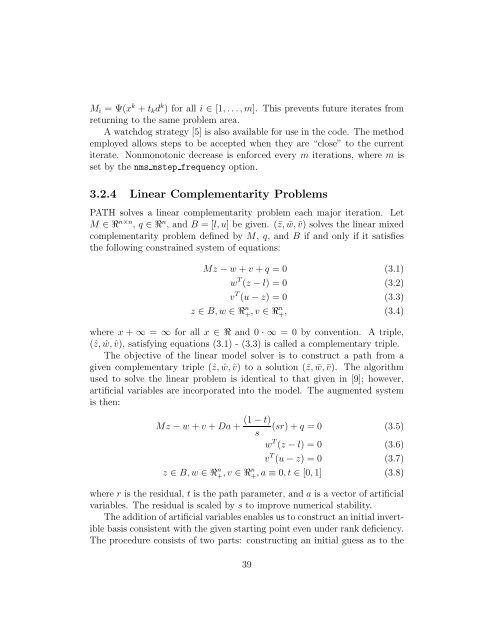GAMS/PATH User Guide Version 4.3
GAMS/PATH User Guide Version 4.3
GAMS/PATH User Guide Version 4.3
You also want an ePaper? Increase the reach of your titles
YUMPU automatically turns print PDFs into web optimized ePapers that Google loves.
Mi =Ψ(x k + tkd k ) for all i ∈ [1,...,m]. This prevents future iterates from<br />
returning to the same problem area.<br />
A watchdog strategy [5] is also available for use in the code. The method<br />
employed allows steps to be accepted when they are “close” to the current<br />
iterate. Nonmonotonic decrease is enforced every m iterations, where m is<br />
set by the nms mstep frequency option.<br />
3.2.4 Linear Complementarity Problems<br />
<strong>PATH</strong> solves a linear complementarity problem each major iteration. Let<br />
M ∈ℜ n×n , q ∈ℜ n ,andB =[l, u] begiven.(¯z, ¯w, ¯v) solves the linear mixed<br />
complementarity problem defined by M, q, andB if and only if it satisfies<br />
the following constrained system of equations:<br />
Mz − w + v + q =0 (3.1)<br />
w T (z − l) = 0 (3.2)<br />
v T (u − z) = 0 (3.3)<br />
z ∈ B,w ∈ℜ n + ,v ∈ℜn + , (3.4)<br />
where x + ∞ = ∞ for all x ∈ℜand 0 ·∞ = 0 by convention. A triple,<br />
(ˆz, ˆw, ˆv), satisfying equations (3.1) - (3.3) is called a complementary triple.<br />
The objective of the linear model solver is to construct a path from a<br />
given complementary triple (ˆz, ˆw, ˆv) toasolution(¯z, ¯w, ¯v). The algorithm<br />
used to solve the linear problem is identical to that given in [9]; however,<br />
artificial variables are incorporated into the model. The augmented system<br />
is then:<br />
(1 − t)<br />
Mz − w + v + Da + (sr)+q =0 (3.5)<br />
s<br />
w T (z − l) = 0 (3.6)<br />
v T (u − z) = 0 (3.7)<br />
z ∈ B,w ∈ℜ n + ,v ∈ℜn + ,a≡ 0,t∈ [0, 1] (3.8)<br />
where r is the residual, t is the path parameter, and a is a vector of artificial<br />
variables. The residual is scaled by s to improve numerical stability.<br />
The addition of artificial variables enables us to construct an initial invertible<br />
basis consistent with the given starting point even under rank deficiency.<br />
The procedure consists of two parts: constructing an initial guess as to the<br />
39

















